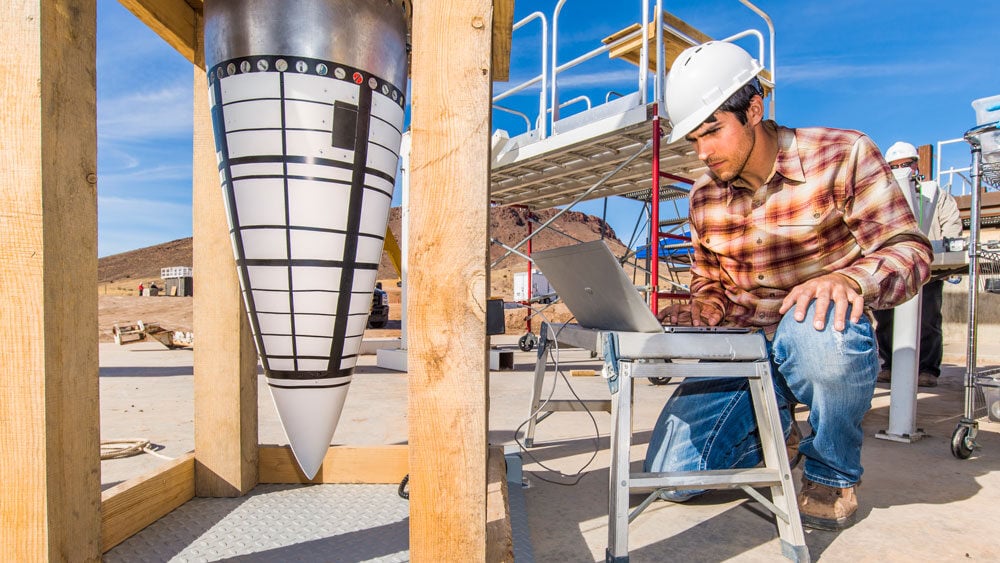
In a photo from 2015, Tyler Keil, Sandia lead engineer for an impact test series using Sandia’s Davis gun, performs a final diagnostics check on a data recorder for an impact test on the nose assembly of a mock B61-12, mounted on an aluminum tube to replicate the body of the bomb. (Photo by Randy Montoya from the archives)
WASHINGTON — The Biden administration announced today its intention to create a new variant of America’s nuclear gravity bomb, dubbed the B61-13.
The decision is a direct result of the findings from the 2022 Nuclear Posture Review and seeks to give the US “additional options against certain harder and large-area military targets,” according to a Pentagon fact-sheet [PDF] that accompanied the announcement.
In a statement, Assistant Secretary of Defense for Space Policy John Plumb said the decision “is reflective of a changing security environment and growing threats from potential adversaries. The United States has a responsibility to continue to assess and field the capabilities we need to credibly deter and, if necessary, respond to strategic attacks, and assure our allies.”
While DoD has oversight on the delivery systems for nuclear weapons, all nuclear warhead modernization is run through the National Nuclear Security Administration (NNSA), a semi-independent branch of the Department of Energy.
RELATED: New Pentagon report details China’s growing nuclear arsenal, possible new missile effort
The new design will build on the ongoing B61-12 life-extension program, which has its origins in the Obama administration. That effort is consolidating the older B61-3, -4, -7 and -10 variants while updating with newer technologies. The first production unit of the B61-12 rolled out in November 2021, with production scheduled through the end of fiscal 2025. The program is estimated to cost $9.6 billion in FY22 dollars over its lifespan, although much of that cost has already been spent, according to an annual government accounting of nuclear warheads [PDF].
Technically, neither the B61-12 or -13 are “new” nuclear weapons that increase the stockpile, as they are taking the warheads from the older bombs and placing them in new housings. (The DoD factsheet notes that number of B61-12s planned for production “will be lowered by the same amount as the number of B61-13s produced.”)
According to the factsheet, the B61-13 “will have a yield similar to the B61-7, which is higher than that of the B61-12. The B61-13 will include the modern safety, security, and accuracy features of the B61-12.” The B61-7 is capable of a 360 kiloton blast, according to analysts Hans Kristensen and Matt Korda writing on the Federation of American Scientists’ website, which would represent a major step up from the 50 kiloton B61-12.
“Although government officials insist that the B61-13 plan is not driven by new developments in adversarial countries or a new military targeting requirement, increasing the accuracy of a high-yield bomb obviously has targeting implications,” the two wrote Friday. “Detonating the weapon closer to the target will increase the probably that the target is destroyed, and a very hard facility could hypothetically be destroyed with one B61-13 instead of two B61-12s.”
It’s unclear what the new design will cost, but based on the release, production of the B61-13 may follow a similar plan to when the Trump administration created the W76-2, a variant of the already-in-production W76-1 with a lower yield. If the only change between the -12 and -13 variants is an increased yield, it should be fairly easy to cut into the production line and move out into the field.
“Since the bombers will now carry both B61-12 and B61-13 bombs (in addition to the new [Long Range Stand Off] cruise missiles), and because the actual number of targets requiring a high-yield gravity bomb is probably small, it seems likely that the number of B61-13 bombs to be produced is very limited — perhaps on the order of 50 weapons — and that production will happen at the back end of the B61-12 schedule in 2025,” Kristensen and Korda wrote.
In 2020, the F-15E became the first American jet to be certified to carry the B61-12, but the bomb is expected to be certified for use by the F-35, F-15, F-16 and B-2, as well as Tornado aircraft in Europe. However, Kristensen and Korda state that the B61-7 is not designed for use by fighters, and indicated they suspected the B61-13 will also be restricted to bombers: the B-2 and, eventually, the B-21.
In a statement, the two top Republicans on the armed services committees — Rep. Mike Rogers of Alabama, Chairman of the House Armed Services Committee, and Sen. Roger Wicker of Mississippi, the Ranking Member of the Senate Armed Services Committee — said they “welcome” the move, but warned it is “only a modest step in the right direction.”
“The B61-13 is not a long-term solution, but it will provide our commanders, particularly in INDOPACOM and EUCOM, with more flexibility against these target sets,” the two men wrote. “Dramatic transformation of our deterrent posture — not incremental or piecemeal changes — is required to address this threat.” (The statement did not spell out what more the legislators would like to see done.)
Jon Wolfsthal, a former Obama-era nuclear official who is now Director of Global Risk at the Federation of American Scientists, told Breaking Defense that the announcement may be a way to phase out the larger B83 nuclear bomb.
“We tried to retire most of B83s under Obama because the military said they were not needed,” Wolfsthal said, a move later walked back under the Trump administration. “Now we remain stuck with it, and it’s costly to maintain and not all that safe. So I see this move for a new B-61 variant as a way to convince the Hill we can get rid of the B83.”
Air Force awards SNC $13B contract for new ‘Doomsday’ plane
The win is a major victory for the firm in a competition that saw the surprise elimination of aerospace giant Boeing.


























